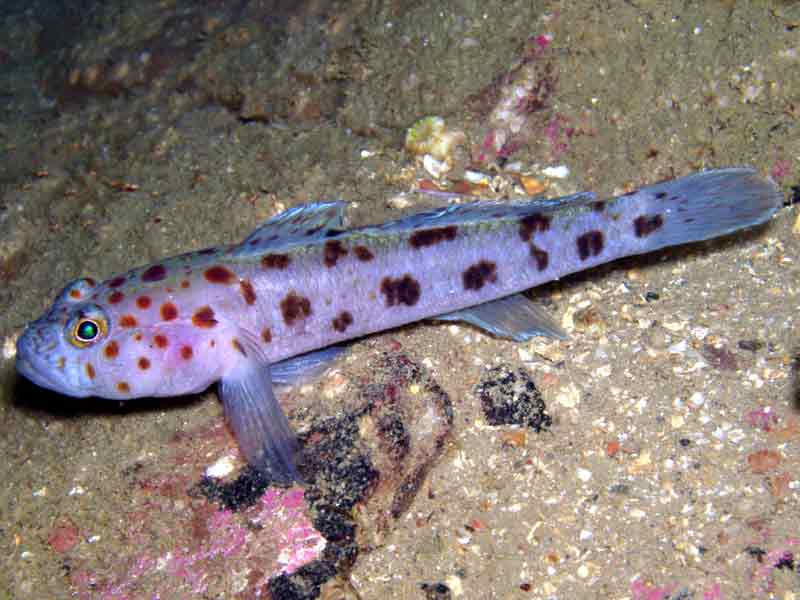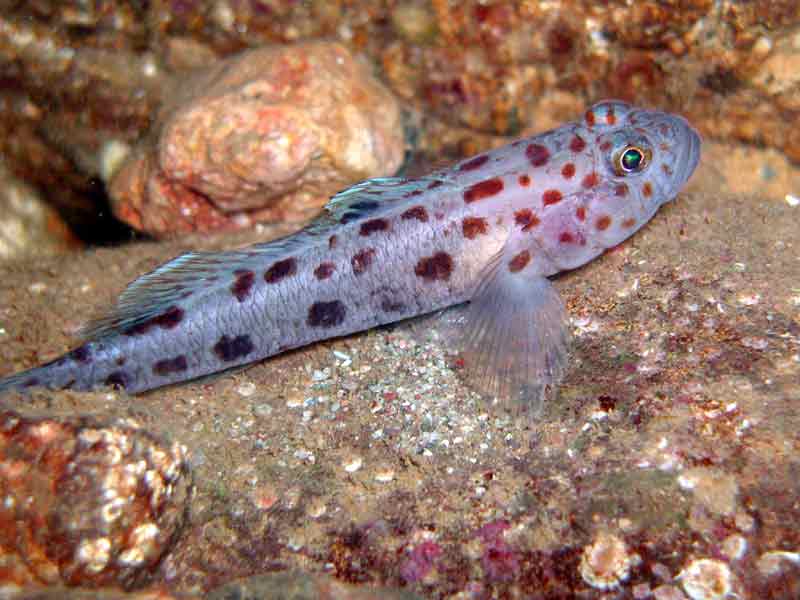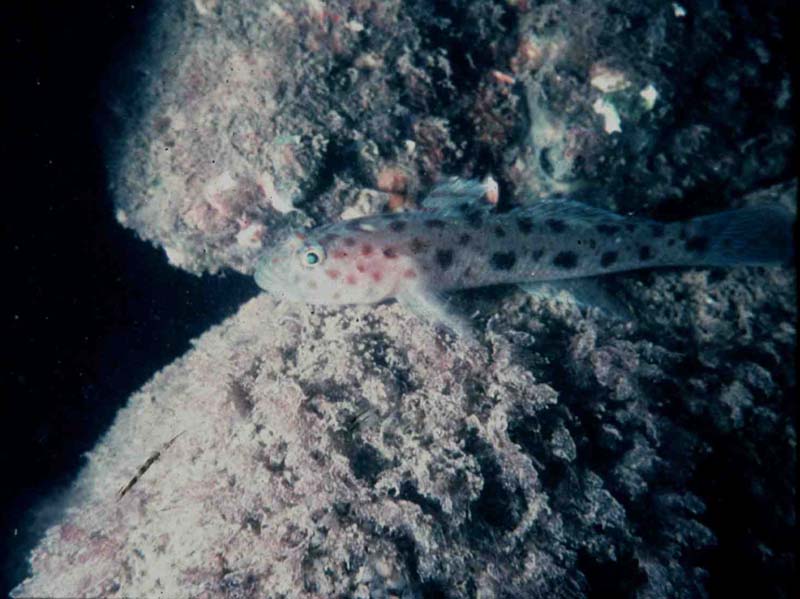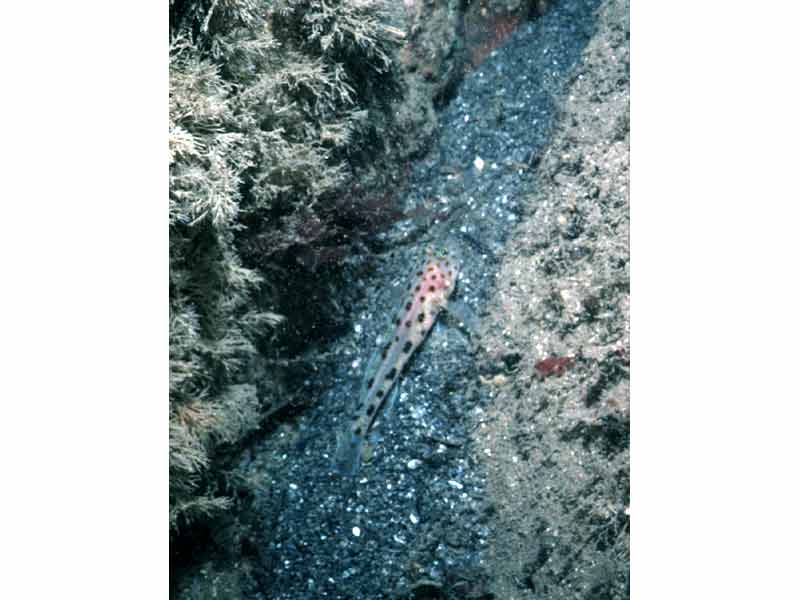Leopard-spotted goby (Thorogobius ephippiatus)
Distribution data supplied by the Ocean Biodiversity Information System (OBIS). To interrogate UK data visit the NBN Atlas.Map Help
| Researched by | Catherine MacDougall | Refereed by | Admin |
| Authority | (Lowe, 1839) | ||
| Other common names | - | Synonyms | - |
Summary
Description
Recorded distribution in Britain and Ireland
Widespread around the coasts of England except for the east coast most likely due to a lack of suitable habitat.Global distribution
-Habitat
Lives in fissures of steep rock faces inshore or a short distance offshore. They also live in sheltered estuaries and sea lochs. Their depth distribution ranges from low water of spring tides to about 40 m. Some individuals may be found in deeper rockpools.Depth range
-Identifying features
- Light brown with orange, red or black spots all over the head and body.
- A black spot on the rear of the first dorsal fin.
- Around 12-13 cm in length.
- Mouth has characteristic thick lips.
- Close set eyes near the top of the head.
Additional information
The leopard-spotted goby is a shy and retiring species. It is normally found by divers on the ledges in front of their home cave or fissure, or at the base of a large stable boulder with underboulder holes available for cover. They prefer shady, darker areas and feed mainly on small amphipod crustaceans and worms.The fish is not caught by remote methods and, when the species was first found by divers in the Plymouth area in 1956, it was thought to be new to science and is listed as Gobius sp. in the Plymouth Marine Fauna (MBA, 1957).
Listed by
- none -
Bibliography
Dipper, F., 2001. British sea fishes (2nd edn). Teddington: Underwater World Publications Ltd.
FishBase, 2000. FishBase. A global information system on fishes. [On-line] http://www.fishbase.org, 2001-05-03
Hayward, P., Nelson-Smith, T. & Shields, C. 1996. Collins pocket guide. Sea shore of Britain and northern Europe. London: HarperCollins.
Howson, C.M. & Picton, B.E., 1997. The species directory of the marine fauna and flora of the British Isles and surrounding seas. Belfast: Ulster Museum. [Ulster Museum publication, no. 276.]
MBA (Marine Biological Association), 1957. Plymouth Marine Fauna. Plymouth: Marine Biological Association of the United Kingdom.
Wheeler, A., 1969. The fishes of the British Isles and north-west Europe. London: Macmillan.
Whitehead, P.J.P., Bauchot, M.-L., Hureau, J.-C., Nielson, J. & Tortonese, E. 1986. Fishes of the North-eastern Atlantic and the Mediterranean. Vol. I, II & III. Paris: United Nations Educational, Scientific and Cultural Organisation (UNESCO).
Datasets
Cofnod – North Wales Environmental Information Service, 2018. Miscellaneous records held on the Cofnod database. Occurrence dataset: https://doi.org/10.15468/hcgqsi accessed via GBIF.org on 2018-09-25.
Fenwick, 2018. Aphotomarine. Occurrence dataset http://www.aphotomarine.com/index.html Accessed via NBNAtlas.org on 2018-10-01
Isle of Wight Local Records Centre, 2017. IOW Natural History & Archaeological Society Marine Records. Occurrence dataset: https://doi.org/10.15468/7axhcw accessed via GBIF.org on 2018-09-27.
Kent & Medway Biological Records Centre, 2017. Fish: Records for Kent. Occurrence dataset https://doi.org/10.15468/kd1utk accessed via GBIF.org on 2018-09-27.
NBN (National Biodiversity Network) Atlas. Available from: https://www.nbnatlas.org.
OBIS (Ocean Biodiversity Information System), 2025. Global map of species distribution using gridded data. Available from: Ocean Biogeographic Information System. www.iobis.org. Accessed: 2025-07-31
South East Wales Biodiversity Records Centre, 2018. SEWBReC Fish (South East Wales). Occurrence dataset: https://doi.org/10.15468/htsfiy accessed via GBIF.org on 2018-10-02.
Citation
This review can be cited as:
Last Updated: 20/11/2002






